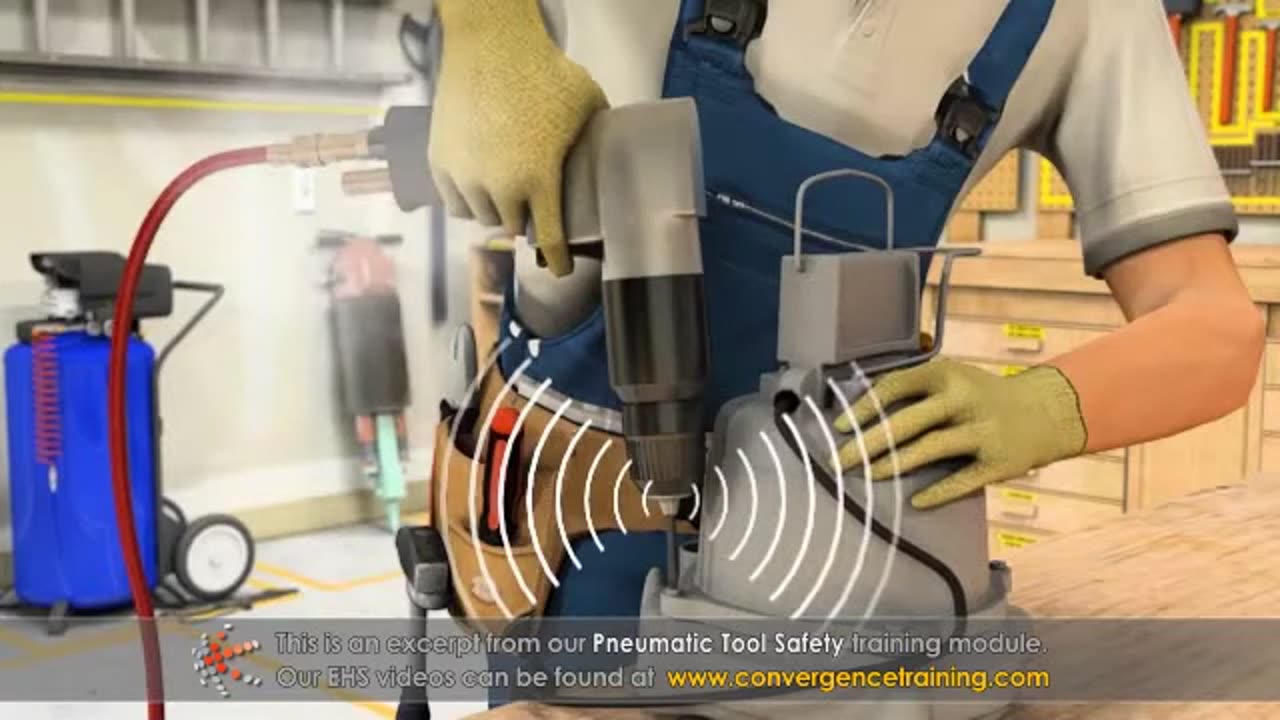Premium Only Content

Pneumatic Tool Safety Training
**Pneumatic Tool Safety Training** is essential to prevent injuries and ensure safe operation of air-powered tools in workplaces like construction sites, factories, and workshops. Below is a comprehensive guide for conducting effective training:
---
### **1. Objectives of the Training**
- Educate users on safe operation, maintenance, and handling of pneumatic tools.
- Reduce risks of injuries caused by improper use or tool malfunctions.
- Promote adherence to workplace safety standards and regulations.
---
### **2. Common Hazards Associated with Pneumatic Tools**
- **Compressed Air Hazards**: High-pressure air can cause serious injuries or be a fire hazard.
- **Flying Debris**: Loose materials can become projectiles.
- **Noise**: High decibel levels can cause hearing damage.
- **Ergonomic Risks**: Repetitive use or poor posture can lead to musculoskeletal injuries.
- **Hose and Fitting Issues**: Damaged hoses can whip violently under pressure.
- **Tool Malfunctions**: Defective tools may misfire or fail.
---
### **3. Personal Protective Equipment (PPE)**
- **Mandatory PPE**:
- Safety goggles or face shields (to protect against debris).
- Hearing protection (earplugs or earmuffs).
- Gloves (cut-resistant and vibration-dampening).
- Steel-toed boots (for dropped tool protection).
- **Optional PPE**:
- Respirators if using tools in dusty or chemical environments.
---
### **4. Safe Operation Practices**
#### **a. Pre-Use Inspections**
- Check the tool and hose for:
- Cracks, wear, or damage.
- Proper connections and fittings.
- Secure and functional guards or safety mechanisms.
- Ensure the pressure regulator is set to the tool's rated pressure.
#### **b. Proper Handling**
- Use both hands to maintain control, especially for larger tools.
- Never point the tool at yourself or others, even if not in use.
- Always disconnect the air supply before servicing, changing accessories, or storing the tool.
#### **c. Safe Connection Practices**
- Use secure, locking couplers to prevent accidental disconnection.
- Depressurize hoses before connecting or disconnecting them.
- Avoid kinks, tangles, or running hoses through high-traffic areas.
#### **d. Usage Guidelines**
- Operate within the manufacturer’s recommended pressure limits.
- Avoid using compressed air to clean clothing or skin.
- Work in well-ventilated areas to prevent fume buildup.
- Use the correct attachments and accessories designed for the specific tool.
#### **e. Safe Storage**
- Store tools in a clean, dry location to prevent rust and contamination.
- Coil hoses properly and away from heat sources or sharp edges.
---
### **5. Maintenance Best Practices**
- Regularly inspect and lubricate tools per manufacturer guidelines.
- Replace worn or damaged parts immediately.
- Ensure hoses are stored without twists or kinks to prolong their life.
- Use only compatible and high-quality parts and fittings.
---
### **6. Emergency Procedures**
- Train employees to:
- Shut off the air supply in emergencies.
- Address hose blowouts safely by releasing pressure.
- Administer first aid for cuts, bruises, or other injuries caused by pneumatic tools.
---
### **7. Specific Training for Tools**
- **Nail Guns**: Avoid using nails in materials that can ricochet; secure materials firmly.
- **Impact Wrenches**: Use proper torque settings to prevent tool strain or damage.
- **Grinders**: Use guards and ensure the grinding wheel is in good condition.
- **Chisels/Drills**: Secure the workpiece and use appropriate bits for the material.
---
### **8. Compliance and Workplace Policies**
- Follow OSHA guidelines (e.g., CFR 1910.242 for pneumatic tools).
- Encourage reporting of unsafe conditions or tool defects.
- Post clear signage about maximum air pressure limits and tool handling protocols.
---
### **9. Hands-On Training**
- Allow workers to practice:
- Connecting and disconnecting hoses safely.
- Adjusting pressure settings.
- Handling tools in simulated or real work environments.
- Use demonstrations to show the effects of improper pressure or tool misuse.
---
### **10. Follow-Up and Refresher Training**
- Schedule periodic reviews to reinforce best practices.
- Incorporate feedback from workers to address specific concerns or incidents.
- Update training materials when new tools or safety standards are introduced.
---
Would you like assistance with creating slides, checklists, or printable safety guides for this training?
-
 6:54
6:54
HSESafetyInformation
9 months ago6 Must Try Breakfast recipes By Food Fusion
421 -
 LIVE
LIVE
Red Pill News
2 hours agoA Deep State Christmas Carol - The Ghosts of Mass Shootings Past on Red Pill News Live
3,445 watching -
 1:18:39
1:18:39
Russell Brand
3 hours agoThe Return of Control: From Lockdowns to Censorship to War - SF663
112K30 -
 1:10:01
1:10:01
vivafrei
5 hours agoRob Reiner & Wife Murdered! Son Arrested & Held on $4 Million Bond! And More! Viva Frei Live!
43.2K54 -
 35:17
35:17
Stephen Gardner
2 hours ago🟢YES! Trump GETS UNEXPECTED news as Democrats LOSE Americas Trust!
16.8K20 -
 17:33
17:33
Cash Jordan
7 hours ago25,000 Homeless SEIZE NYC’s Subway… as “Communist Mayor” HANDS CITY to SQUATTERS
49.4K35 -
 6:59
6:59
Buddy Brown
3 hours ago $1.36 earnedSCARY Message about the 1930's Going viral now... | Buddy Brown
21.2K9 -
 LIVE
LIVE
LFA TV
1 day agoLIVE & BREAKING NEWS! | MONDAY 12/15/25
1,167 watching -
 1:29:35
1:29:35
The HotSeat With Todd Spears
2 hours agoEP 226: Not "If" But, When.....Is the "When" here?
21.2K9 -
 1:07:53
1:07:53
The Quartering
4 hours agoCandace Owens & Erika Kirk MEET, Terror In LA Stopped, Brown University Debacle & Australia Attack
134K31